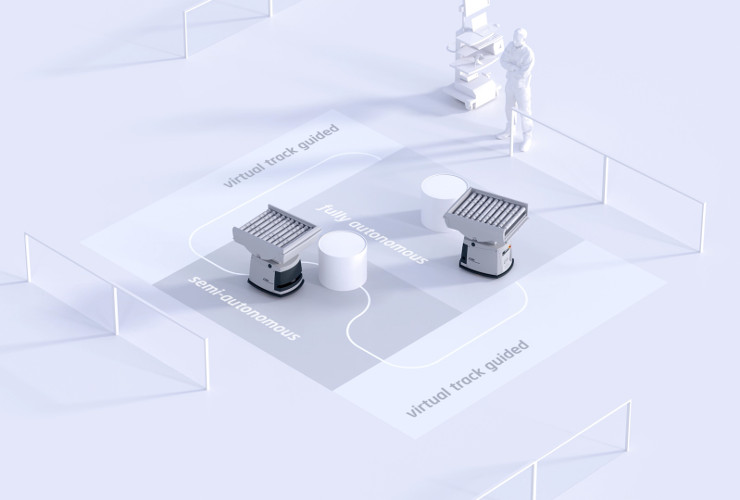IFOY Test Report: ARCOS by DS Automotion
31st May 2023

The latest submission in the IFOY Award finalists to come under the microscope ahead of the announcement ceremony in Dortmund on June 22nd is the ARCOS AGV/AMR from DS Automotion.
Category: Intralogistics Software
IFOY Test Report
Automated Guided Vehicles (AGV) are known for the tireless execution of their transport orders. They travel rigidly predefined routes and deliver the respective transport loads to their destinations. Each lane, curve or intersection is carefully planned to realise the highest possible efficiency of the system. Mutual obstruction of the vehicles or even blocking is thereby ruled out.
Autonomous Mobile Robots (AMR), on the other hand, are responsible for reaching their destinations themselves. They are often only provided with the target and a map of the operational environment. With the help of sensors, they then continuously record their environment and can react independently to changes. Planning their paths independently allows them to avoid obstacles, but carries the risk that decisions made may negatively affect the efficiency of the overall system. The individual vehicles can interfere with or even block each other.
It is understandable that for plant operators it is tempting to use the positive features of both worlds. Therefore, DS Automotion has combined the strengths of both worlds (AMR and AGV), setting a milestone in the industry. According to the operator’s requirements, vehicles can act autonomously and avoid obstacles without blocking, but also follow pre-planned lanes.
The innovations are not only characterised by the coining of the terms “plannable autonomy” and “cooperative navigation”, as new core functions of the vehicle software. Conformity with the VDA-5050 interface, which is used across fleets, is also worth highlighting.
“Schedulable autonomy” is a way to navigate vehicles both “virtually lane-guided” and autonomously. The basic building blocks for this are the autonomy zones in which vehicles move freely. “Cooperative navigation” describes the ability of autonomously navigating vehicles to work together to find solutions to problematic situations. For example, the vehicles independently clarify the right of way between vehicles at intersections or bottlenecks.
IFOY test verdict: With the new software, DS Automotion vehicles can be quickly and easily integrated into production or logistics processes. In combination with the fleet manager NAVIOS, the planning and integration effort is reduced via the web-based interface. The zone-based planning and transport flow editor included in it enable the operator to adapt and expand the system. Transportation systems that use AMR with full autonomy typically have limited ability to intervene in the process. Here, the “schedulable autonomy” functions offer the possibility to define the behaviour of the vehicles more precisely. As in the case of virtual lane-guided AGVs, complex systems are thus realised with the highest possible efficiency. Due to the standardised interface, the operator can integrate the system into an already existing plant with VDA-5050 interface and also expand it at any time.
IFOY Innovation Check
Market relevance: ARCOS vehicle software combines the high flexibility of autonomous mobile robots (AMR) with the high efficiency of automated guided vehicles (AGV) in one transport system. As more warehouses, production facilities and hospitals are equipped with transport vehicles and the flexibility requirements in terms of throughput, environment complexity and task structure become more demanding, solutions like ARCOS are an important step in getting the best possible performance out of automated transport systems. Due to the breadth of application fields and the open interfaces of ARCOS, the market potential is estimated to be quite high. A first customer installation in a hospital environment is expected to go into operation shortly.
Customer benefit: With its so-called “Plannable Autonomy”, ARCOS promises maximum transport process efficiency by optimally merging the advantages of track-guided and autonomous transport vehicles in one vehicle software. However, the degree of autonomy can so far only be defined in spatially delimited zones, but not based on other, situational criteria. In addition, “Collaborative Navigation” in autonomous operation ensures that the optimal driving behaviour between the vehicles is coordinated independently at intersections or bottlenecks and that blockages are ruled out. ARCOS is compatible with all fleet managers, can also be used across manufacturers via VDA 5050, and can also be used in fleets with more than 100 vehicles.
Novelty / Innovation: Plannable Autonomy, i.e., the seamless integration of track guidance, partial autonomy, and free navigation in one vehicle software is new in this quality of integration in one solution. Although collaborative navigation is not an entirely new function, it is not coordinated centrally as in other solutions, but solved decentral only by the robots involved. Innovative dynamic lock zones are also used in this context.
Functionality / Type of implementation: The functionalities of plannable autonomy as well as collaborative navigation were shown to be of high quality and robust in several tests, some of which were very demanding. The collaborative navigation can also resolve difficult and dynamic situations and coordinate any number of vehicles with each other. One limitation of decentralised motion planning, however, is the operational range within a radius of approximately 10m. The applicability of ARCOS on all common chassis kinematics is exemplary.
Verdict: For the first time, ARCOS enables AGV and AMR fleets to drive variably, but zone-based between fixed lane guidance, lane guidance with flexible evasion, and free navigation (plannable autonomy) with a single flexible vehicle software. In combination with cooperative navigation, which enables the robots to avoid each other in a coordinated manner, a very efficient, powerful, and high-quality solution is offered that can also integrate vehicles from other manufacturers via VDA 5050.
Market relevance +
Customer benefit ++
Novelty / Innovation +
Functionality / Type of implementation ++
[KEY: ++ very good / + good / Ø balanced / – less / — not available]

